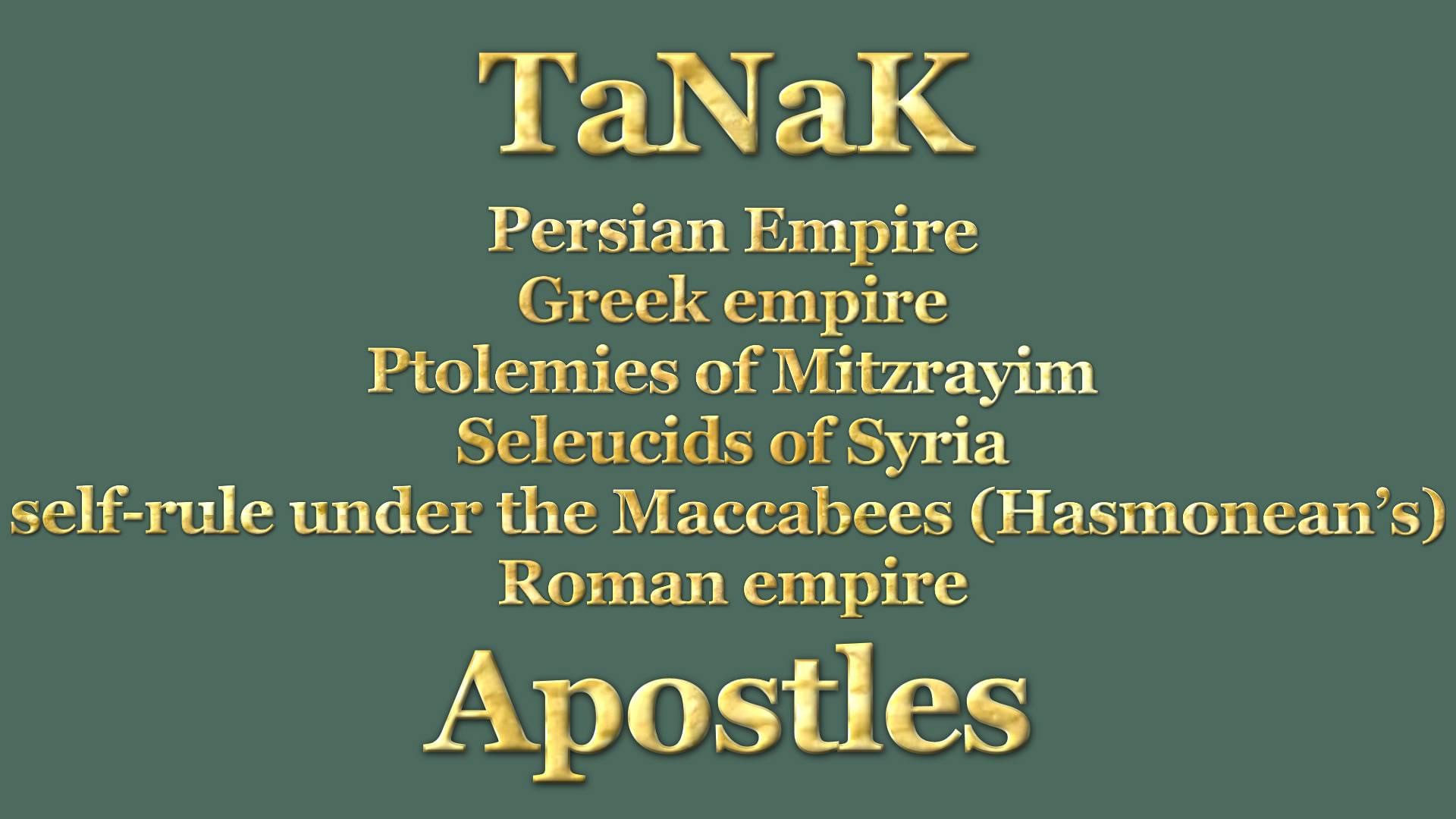Watch
Events
Articles
Market
More
Introduction and the Historical Background of the Intertestamental Period
The timeline of the TaNaK ends with the Yehudym newly re-established in their land. During the time from Malaky to the coming of Moshiach, the people of Yisrael lived under six different governments: the Persian Empire, the Greek empire, the Ptolemies of Mitzrayim, the Seleucids of Syria, self-rule under the Maccabees (Hasmonean’s), and finally under the rule of the Roman empire. The following is a brief chronology of those six intertestamental eras.
The Persian Empire (549 - 330 1B.C.E). Cyrus (559 - 530 B.C.E.) inaugurated the Persian Empire with his conquest of Media in 549 B.C.E., and Bavel in 539 B.C.E. Cyrus’ policy was to allow peoples exiled by the armies of Bavel to return to their homelands, rebuild, and reinstitute their forms of worship. From 538 to 430 B.C.E., many Yehudym returned to eretz Yisrael, where they restored Yerushalayim, rebuilt the Heykal, and re-established their lives in relative peace. Those Yehudym who remained in Mesopotamia largely assimilated there and enjoyed prosperity. The very last historical narratives in the TaNaK recount this period.
Greek rule: (331 - 320 B.C.E.). When Alexander "the Great" of Macedonia (336 - 323 B.C.E.) conquered and annexed the Persian Empire, very little changed for the Yehudym. Alexander’s rule, though brief, was nevertheless formative for all of Western culture. He extended the use of the Greek language throughout the Mediterranean world and the Near East. He founded the city of Alexandria in Mitzrayim, which became a Greek cultural center for several hundred years. During his reign, Alexander was recognized as a deity, setting a precedent for later rulers of Greece and Rome. Following Alexander’s death, his top generals struggled for dominance, each in their own realms, and by the year 320 B.C.E., the divisions among them were settled. The two of these kingdoms that most impacted the Yehudym were Mitzrayim, under thePtolemies (323 - 30 B.C.E.), and Syria, under the Seleucids (321 - 64 B.C.E.).
Mitzry Rule: (Ptolemies 320 - 198 B.C.E.). Yisrael fell under the control of the Ptolemy I of Mitzrayim sporadically between 320 and 301 B.C.E. and subsequently Mitzry control was settled for a century. The Ptolemies had a generally peaceable relationship with the Yehudym. Ptolemaic rule brought Greek peoples and culture to the nation of Yisrael. However, this “hellenization,” as it has been called, eventually became an existential challenge to Yehudy culture and religion. The Greek translation of the TaNaK or “Septuagint,” was begun during this time (c.285 B.C.E.), and was finally completed sometime during the late second century B.C.E.
Syrian Rule: (Seleucids 198 - 142 B.C.E.). When Seleucid King Antiochus III of Syria (223 - 187 B.C.E.) won the Yehudym territories from the Ptolemies in 198 B.C.E., he continued to tolerate the Yehudy religion and the rule of its priesthood over both civil and religious affairs. But these policies ended when his son, Antiochus IV Epiphanies, took the throne in 175 B.C.E. Antiochus Epiphanies sought to ruthlessly impose unified hellenistic culture and religion on the entirety of his kingdom. He gave the Yehudy Koheyn Gadol’s position to the highest bidder sympathetic with his reign. Finally, in 167 B.C.E., during his return to Syria after a humiliating defeat in Mitzrayim at the hands of the Romans, Antiochus lashed out at Yisrael by brutalizing its people, banning the Yehudy faith, and murdering all of the Yehudym who refused to give up their faith and traditions.
The heat of this unwarranted persecution forged Yehudy resistance. A Koheyn in the city of Modin named Mattithyahu, followed by his five sons (nicknamed the Maccabees, “hammers”), led a revolt against Syrian rule. In 164 B.C.E., that revolt succeeded in temporarily gaining Yisrael’s freedom. The Heykal was restored to service by the Maccabees and rededicated on the 25th day of the 12th solar month, 164 B.C.E. This day is now celebrated as the festival of Chanukkah, which means “Dedication.” Antiochus Epiphanies died during this period while on a campaign to reassert his rule in Persia. One of Mattithyahu's sons, Yehudah Maccabeus, was killed in 160 B.C.E. in one of a series of battles that brought the Yehudym once again under Seleucid rule. However, with Antiochus dead and a new ruler in Syria the Yehudym were not immediately subjected to such fierce religious persecution as they previously had been.
Semi-Independence: Hasmonean Dynasty (142 - 63 B.C.E.). In 142 B.C.E., Syria granted Yehudah partial independence. For most of the following century the Yehudym were self-governed under the Hasmonean Dynasty, the descendents of the Maccabees. However, as time went on, the Hasmonean’s began to compromise their faith and traditions, and to embrace hellenistic perspectives and policies in order to better integrate with the nations surrounding them. In violation of Torah law, the ruler of Yisrael also became the Kohen Hagadol. Not surprisingly, given this concentration of power, corruption and abuses quickly arose among the Hasmonean rulers. The party of the P'rushym (or "Pharisees") came into ascendancy at this time, opposing hellenization and the absolute power of a single ruler as koheyn-governor. The Tzadoqym (or “Sadducees”), descendants of Aharon Hakohayn, Moshe's brother, also arose, supporting hellenization and the power of the new Kehunnah which they controlled.
Roman Rule: (63 B.C.E. – 135 CE). Throughout the first century B.C.E., Rome steadily increased its power over the Mediterranean world. In sixty-three B.C.E. the Roman general Pompey made Yisrael a vassal-state of Rome, and Yehudym independence was no more. When Hyrcanus II, the last Hasmonean ruler, finally died in 40 B.C.E., an Idumean named Herod was well-positioned to take limited control of Yehudah. He was supported in Rome by Octavian and Mark Antony and strengthened by his marriage to the Hasmonean Princess, Miriam, the granddaughter of Hyrcanus II. So Herod the Great became king in 37 B.C.E. and reestablished a separate great Kehunnah - the "Kehunnah Hagadolah." By the turn of the first century CE, the Pax Romana - the militarily enforced "Peace of Rome" - was fully established, and Yisrael was firmly in its grip under the rule of Herod’s successors.
It was in that time and under the Roman hegemony that Yehoshua, our blessed Messiah, was born in Bethlehem, raised in Natzereth, and came into his ministry throughout the land. But, that is another story. This present one begins with Mattithyahu and his sons, kohanym of YHWH Most-High, as they were living in peace in the city of the Modim under Syrian rule…
Sabbath Keepers Fellowship & Prison Ministry
August 2017



